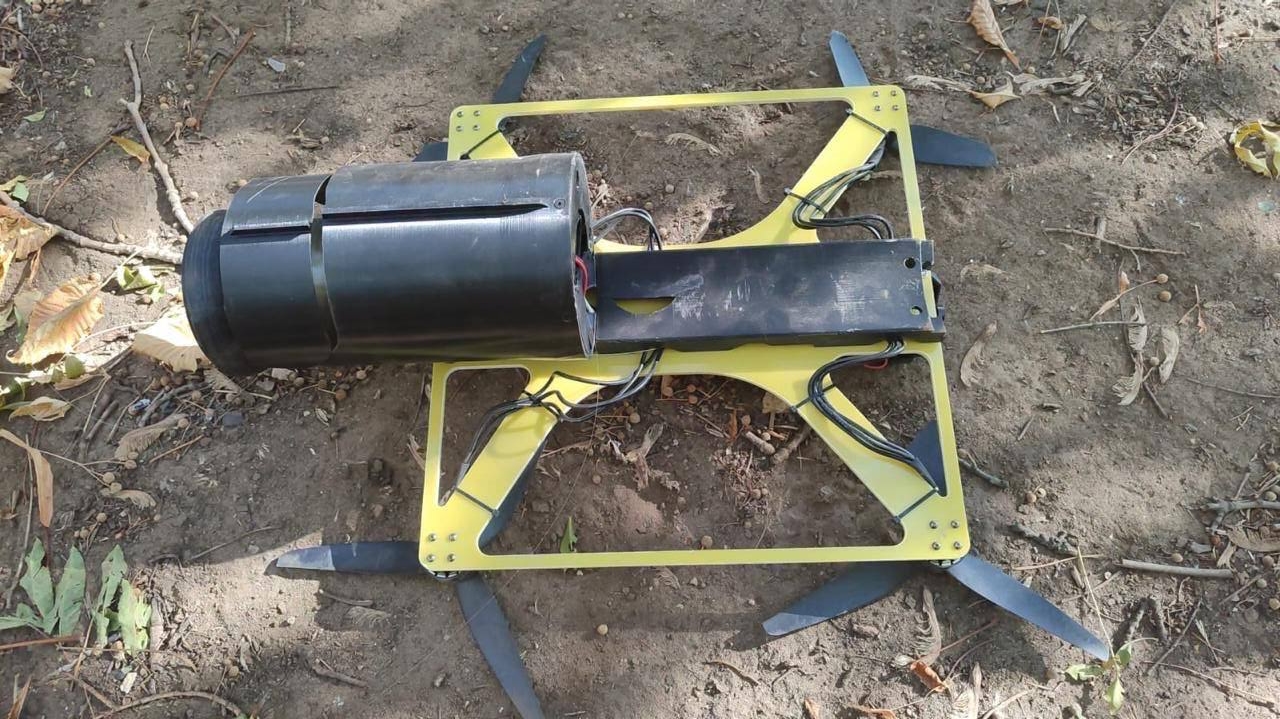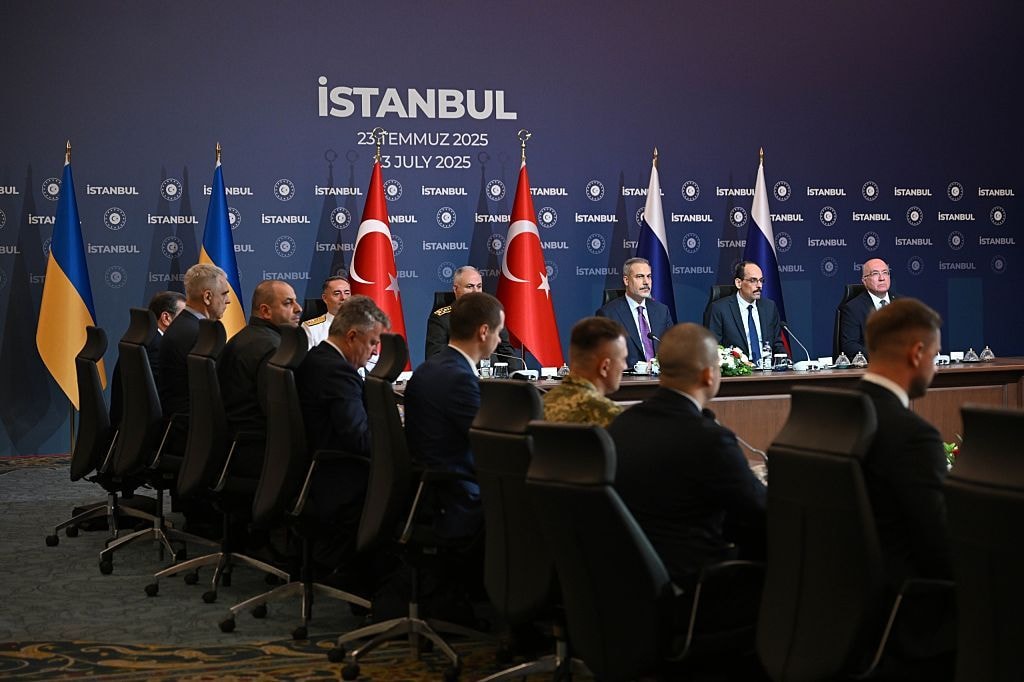
As Russia’s fiber optic drones flood the battlefield, Ukraine is racing to catch up
A batch of fiber optic FPV (first-person view) drones is seen before being handed over to the Ukrainian Armed Forces in Kyiv, Ukraine, on April 1, 2025. (Mykhaylo Palinchak / SOPA Images / LightRocket via Getty Images)
Editor’s Note: In accordance with the security protocols of the Ukrainian military, soldiers featured in this story are identified by first names and callsigns only.
Every year, as the way war is fought constantly evolves on the battlefields of Ukraine, the visuals of the fighting on the ground that constantly flood the internet transform with it.
In the frantic first weeks of the full-scale invasion, it was Russian tanks stolen by farmers tossing their turrets after Ukrainian Javelin strikes. Over the Battle of Bakhmut, we got used to images of brutal World War I-style trench warfare in the 21st century.
2024 was undoubtedly the year of the first-person-view (FPV) drones, with their characteristic screech through the air and messy static picture often capturing the last moments of a soldier’s life.
In 2025, something new has arrived. Images of kilometers-long tunnels of netting erected over entire roads, of city streets and fields covered in a dense tangle of glistening thread, and of the same FPV drone strike footage, but now with perfect camera quality.
This year’s new arrivals on the visual fabric of the battlefield have one thing in common: they are all connected with the weapon shaping entire operations: the fiber optic FPV drone.
In a war defined by constant innovation, this deceptively simple tweak to standard FPV drones makes them immune to electronic warfare (EW) and free of limitations brought by radio horizon.
The drones have already made a serious impact — from their role in Russia’s recapture of Kursk Oblast to the devastation of logistics all across the front line.
What’s more: unlike many of the full-scale war’s most effective innovations, fiber optic drones were first introduced not by pioneering Ukrainian drone teams, but by Russian forces.

What is a fiber optic drone?
At its core, a fiber optic drone of the kind used in Ukraine is simply a modification of the standard FPV drone that has already once transformed the way war is fought.
Usually, this means a quadcopter design on a carbon fiber, aluminum, or polymer frame, upon which electronics are welded on in the middle, a battery is strapped to the top, and — right before flying out on a combat mission — the munition is strapped to the bottom.
The difference is in the communication between the drone and its pilot.
Most FPV drones receive their control inputs and beam back video through standard analog or digital antennas, meaning that maintaining a decent signal connection, even at great distances, is crucial for reaching and engaging targets.
To achieve this, vertical antennas on the drone position are often complemented by signal booster drones, allowing the FPV to fly further, although still limited by the radio horizon of the terrain.
Then there is jamming: EW devices of all shapes and sizes, from smaller systems mounted on vehicles to protect them from FPVs, to larger, more powerful units that can deny a whole area at a distance.
When flying on fiber optic, the drone pilot is not concerned by questions of radio horizon or electronic warfare, and — so long as the fiber itself isn’t damaged or broken mid-flight — can count on a perfect video feed right up to the target.
Often, FPV drones on both sides are jammed by friendly as well as enemy EW, as many different teams from different units work out of the same sector without coordinating who is switching on their EW when.
Fiber optic drones remove all of these problems from the equation, and for that reason, have been game-changing.


Hanging under the drone, usually between the frame and the munition, a large but fairly lightweight cylinder holds a long spool of lightweight optical fiber which gradually releases as the drone flies forward.
Essentially, this makes the drone a wire-guided precision weapon, like the Cold-War era TOW anti-tank missiles developed by the United States.
When flying on fiber optic, the drone pilot is not concerned by questions of radio horizon or electronic warfare, and — so long as the fiber itself isn’t damaged or broken mid-flight — can count on a perfect video feed right up to the target.
Over 2024 especially, both Ukraine and Russia invested heavily in expensive EW systems to protect vehicles and other high-value targets, but against these new drones, they are rendered useless. Likewise, the same goes for radio-based drone detector devices commonly used by units to warn them of FPVs flying in the area.
As has been demonstrated by both sides on the battlefield, fiber optic also allows FPV drones to fly where they never could before.
“They're really great when you need to fly into some kind of building, like a large shed or hangar, to have a look inside if there is something there with the ability to strike it straight away,” said Oleksandr “Skhid,” an FPV drone team commander in Ukraine’s Achilles Strike Drone Regiment. “The same goes for other types of cover, and flying in forested areas.”
The drone design is not without its downsides. The weight and bulk of the fiber optic spool means that a larger drone frame with more powerful motors and a larger battery is needed, creating a final airframe that is slower, less maneuverable, and easier to shoot down with small arms than standard FPV drones.
The hard connection between pilot and drone also leaves a physical trail of fiber after every flight, which, once they start to accumulate, can become visible.
“The fiber is very reflective in the sunlight, and it makes it possible to find the place where you fly out of,” said Skhid. “That's why it's better to switch positions more often.”
Russian origins
In the cat-and-mouse technological game of the full-scale war, it is often Ukraine that has held the reputation of being better innovators, with more motivated engineers and volunteers allowed to work in a more flexible environment.
Often, if a new Ukrainian product or solution proves to be effective on the battlefield — like the early use of the basic FPV drone — Russia tends to copy it and ramp up production.
But with fiber optic drones, Russia was first, and the story of how it happened challenges perceptions of Russia’s war machine as being a lumbering, inert organization.
“Beginning with 2023, many key Russian military commentators, bloggers and military personalities were calling for the Russians not just to match Ukrainian (drone) capabilities step for step, but to essentially achieve a breakthrough,” said military analyst Samuel Bendett, who has closely followed the efforts of grassroots Russian innovators and volunteer efforts over the full-scale war.
At the time, both sides were increasingly looking to artificial intelligence as a solution to the jamming problem, with both solutions like AI-powered target recognition and pixel-locking that allow a drone to fly the last leg of its journey to the target.
Ultimately though, with autonomous targeting often less reliable than a capable pilot and needing more expensive hardware on the drone itself, Russian drone engineers looked to think outside the box, arriving at the idea of the fiber optic drone.
The first fiber optic drone model deployed at scale to the front line was the Knyaz Vandal Novgorodsky, a product of the Ushkuinik military technology accelerator project founded by Russian political scientist-turned volunteer Aleksey Chadaev.
First deployed in Kursk Oblast in August 2024 and scaled up as attempts to expel the Ukrainian presence inside Russian territory accelerated, the drone quickly proved to be extremely effective, particularly at targeting already strained Ukrainian logistics routes across the state border.
By late winter, when Russian assaults on the Kursk salient intensified, soldiers reported that fiber optic drones played a crucial role in making the Ukrainian presence in the salient untenable.

"Our logistics just collapsed; fiber optic drones were monitoring all routes, leaving no way to deliver ammunition or provisions,” said Dmytro, a Ukrainian medic fighting out of the Russian town of Sudzha at the time, to the Kyiv Independent.
“Traveling there was even worse than playing Russian roulette — because in this case, the revolver has five bullets and only one empty chamber."
Now, top Russian drone units, including Rubicon and Sudny Den (“Judgement Day”), with their extensive experience of using fiber optic drones in Kursk Oblast, have transferred to Donetsk Oblast, according to the units’ Telegram channels.
There, they have quickly begun to boost Russian offensive efforts in the area, especially around the front-line hotspots of Pokrovsk and Toretsk.
Speaking to the Kyiv Independent on condition of anonymity, Ukrainian soldiers from two different brigades fighting near Toretsk reported a sharp increase in vehicle casualty rates after more fiber optic drones started flying in the area, with one saying that the whole brigade had run out of medical evacuation vehicles in the space of a month.
With the technology continuing to be refined, and longer spools being fitted to larger drones on both sides, important logistical hubs could come under threat, even without the front line itself getting much closer.
In April, Russian fiber optic drones began to fly into the city of Kostiantynivka, a central logistical node north of Toretsk and just over 10 kilometers from the contact line, with videos posted of both military and civilian vehicles hit.
Playing catch-up
In a nondescript village house in Donetsk Oblast, a young military engineer with the call-sign “Barbara” screws propellers onto a quadcopter drone.
On his desk, alongside the typical markers of drone-making equipment — 3D printers, soldering irons, wires, and zip-ties — are a row of large fiber optic spools.
This humble workshop is where the legendary Azov Brigade of Ukraine’s National Guard, recently promoted to corps level, prepares its new fiber optic drones.
Seeing the importance of the technology, Azov, along with many of Ukraine’s more specialized drone units, has been quicker out of the gate to experiment with and adopt fiber optic drones.
Like with any other drone technology, the unit works in tight cooperation with Ukrainian manufacturers, tightening the feedback loop from factory to front line.
“These types of drones have proven themselves in combat, they've proven their effectiveness, and the Russians are basically saying that this is something they should invest in.”
With Ukraine’s FPV drone production already well-developed at scale, the ability to pivot to more production of fiber optic simply requires a stable access to quality cable, most of which comes from China.
In Ukraine, ready-made fiber optic spools are available for purchase on online marketplace AliExpress, though, as with all drone parts, manufacturers are looking to move away from dependence on China due to the country’s warm relations with the Kremlin.
"Previously, it was mostly just Chinese spools,” he said. “Now, our manufacturers have started to take action and quite successfully. Perhaps, they lost a bit of time, but now all capacities are being ramped up."

In late February, Ukraine’s Unmanned Systems Forces unveiled the Silkworm, a domestically-made fiber modular optic spool that can be used both on FPV drones and unmanned ground vehicles, which also often suffer from comms difficulties on the battlefield.
As Ukrainian production gets into gear, the rapid training of pilots and the establishment of best practices are their own challenges.
Receiving their first fiber optic drones toward the end of the winter, Skhid’s team has continued to fly mostly on standard FPV drones, turning to fiber optic only when absolutely necessary.
“We haven't completely figured out fiber optic yet,” said Skhid. “We have several different manufacturers, we are testing them continuously, we don't have a simple workflow.”
"Right now, I wouldn't say that quantity is the most important thing,” added Barbara. “We need quality, and it’s more important that everyone who deals with fiber optic understands what to do with it and how to handle it."
Transforming the war
So far, the successful use of fiber optic among Ukrainian forces is limited to the top tier of well-equipped, professional drone units, like the Achilles regiment or Azov's native drone battalion.
“This (2025) will be the year of fiber optic,” said Kyrylo Veres, a prominent Ukrainian officer and commander of K-2, another one of the military’s top drone regiments, in an interview with Ukrainian media in March.
“But at the moment, it’s being used effectively by about one in 10 Ukrainian drone units. When we reach a point where nine out of 10 are using it, and the rest are quickly catching up, then we will see some serious results.”
In the meantime, Russia’s current advantage in the use of fiber optic — right as offensive efforts are gaining momentum across the front line with the approach of summer — is proving to be a serious challenge for the Ukrainian defense.
“It was a raw, unproven technology, but it has since expanded and everyone now recognizes this advantage,” said Bendett.
“These types of drones have proven themselves in combat, they've proven their effectiveness, and the Russians are basically saying that this is something they should invest in.”
Countermeasures to fiber optic drones are so far limited to physical shooting down, entanglement, or obstruction.
Along key logistics routes in the deadliest zone of the front line, both sides have been seen setting up long tunnels of lightweight netting for protection from the aerial threat, although videos have also emerged of Russian fiber optic drones simply flying underneath the nets to hit Ukrainian vehicles.

As fiber optic drones are fitted with larger and larger spools, they consistently fly further than most standard FPVs.
The long-term consequences for front-line logistics look to be transformative to the way war is fought, in the same way that drones first made the immediate zero line much deadlier than at the outset of the full-scale invasion.
“At the moment, most of our spools are 10 kilometers long, a few are 15 kilometeкs long, and the 20-kilometer spools are still being tested,” said Skhid.
“I can't wait to try some of the longer-range spools, it will really increase our ability to find all kinds of Russian equipment in buildings further in the rear.”
Note from the author:
Hi, this is Francis Farrell, thanks for reading this article on what could be one of the most understated yet terrifying new weapons of this war. I don’t really know what we are going to do about fiber optic drones, they are making everything more dangerous near the front line, including both soldiers’ and our work. I have a feeling that in the near future, stumbling through spider webs of optical fiber will become a normal part of front-line work. But as with everything, as with this war, we will keep doing what we do because we have no other choice. If you want to stand there with us, without creeping through fiber optic yourself, please consider becoming a member of the Kyiv Independent. To fund our reporting, we rely on our community of over 18,000 members from around the world, most of whom give just $5 a month. We’re aiming to reach 20,000 soon — join our community and help us reach this goal.











